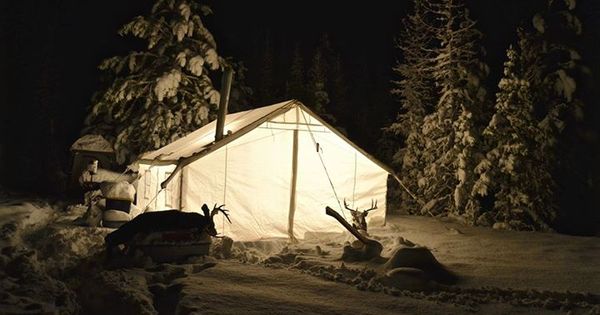Hot tent camping is becoming and increasingly popular activity. While canvas has been the traditional choice in a hot tent for successive generations, nylon is becoming an increasingly popular choice. Nylon is much lighter than canvas and so is an appealing option if weight is a concern.
The other advantage nylon has over canvas is that it is initially a cheaper purchase. A canvas tent can easily run into the thousands of dollars while you can pick up a small nylon tent for under 200 dollars.
However, the initial investment in canvas can in the long run pay off. Why is that? Canvas if well cared for can last a very long time. Nylon on the other hand breaks down fairly quickly in direct sunlight. While we have had our small backpacking nylon tent for over 10 years, it has most certainly reached the end of its life. In fact a nylon tent if used often and in harsh conditions will need to be replaced in about 4-5 years.
How long will a canvas tent last? A Canvas tent if well cared for can last 20-30 years or much longer. Do not leave your tent set up for months at a time without a fly cover, only pack your tent away bone dry, don’t wash your tent with any soap, chemicals or aggressive scrubbing and don’t allow a heavy snow load to build up on your tent roof. These are all important factors that will determine the life span of your tent.
How To Care For Your Canvas Tent
So how can you extend the life of your canvas hot tent? The enemy of canvas is mold. It is very important before storing your canvas tent, to make sure it is bone dry. You also also need to store your tent in a dry area.
If you are leaving your canvas tent up for a period of time, it is good to give some thought to pitch your tent in an area where the part where the tent touches the ground will have a chance to dry.
If you are pitching in an area where the ground stays moist and wet, you may want to consider placing your tent on a wood platform. This way the base of the tent will stay high and dry.
If you are leaving your tent up for a period of time in the winter you may want to consider investing in a tarp cover. A tarp cover can help your canvas tent to shed snow. While many canvas tents are built solidly, they will not hold up under heavy snow loads and can collapse even with a steel frame.
Unlike nylon tents, canvas tents hold up well agianst UV rays. That being said investing in a tarp can help protect your tent further against the elements.
It is also good before packing your tent away to lightly brush off any dirt and you can also hose it off. Again it is important to allow the tent sufficient time to dry before packing away for the season.
When you are hosing the the tent down it is important to not use any soap or chemicals. These can damage the waterproofing and fireproof treatment of these tents. When you are brushing the tent off, it is important to use a soft brush so as not to damage any fibers.
Canvas tents are ideal for hot tent camping. Since you are using a natural fiber, the tent material will breath allowing moisture to pass through the tent. This makes for a comfortable experience particularly while camping in the winter.
It is important when using a stove to make sure it is set up at least 20″ away from the tent walls. You should also make sure that you are using a stove tent jack to run your stove pipe through. You stove pipe should not touch anything other than the jack.
The stove pipe will get hot, particularly at the base. You should keep the heat down if you are noticing a large portion of the pipe turning red. Keep any potentially flammable substances well away from the stove. Make sure the floor around the stove is not easily flammable.
It’s been said that “an ounce of prevention is worth a pound of cure”. By taking small preventive steps to protect your investment, your canvas tent will no doubt last for many happy hot tenting trips.
